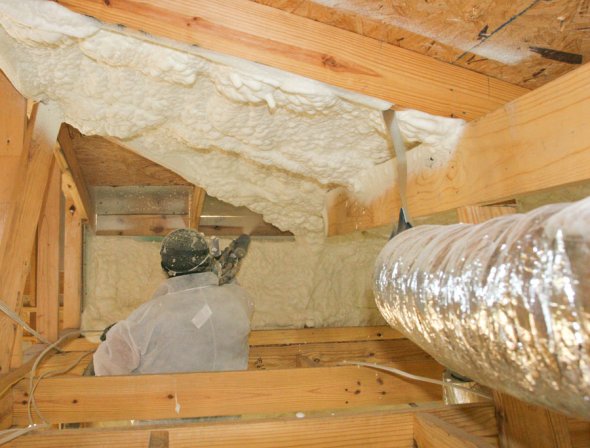
How to recycle foam insulation
Peter Halkias’ contractor had told him from the start that disposing of the waste would be his responsibility. “I am trying to kill two birds with one stone,” he writes in a Q&A post at GreenBuildingAdvisor. “Get rid of the waste and add some insulation R-value to my attic ceiling.”
As an insulator, the foam probably won’t do a lot of good, in part because it provides no resistance to air flow, Halkias is told. And trying to pulverize the foam with equipment typically used for fiberglass or cellulose just makes a dusty mess and a potential fire hazard.
His question, however, raises larger issues about the use of open-cell foam, and that’s at the heart of this week’s Q&A Spotlight.
For openers, who should be responsible for the diposal of the considerable amount of scraps that an installation usually produces? And is it environmentally responsible to haul the scraps to a landfill?
Although open- and closed-cell foam has become a fixture in high-performance buidlings, its petrochemical origins has convinced some builders to look for alternatives.
Read the whole article at Green Building Advisor.
Fine Homebuilding Recommended Products
Fine Homebuilding receives a commission for items purchased through links on this site, including Amazon Associates and other affiliate advertising programs.

Handy Heat Gun

Affordable IR Camera

Reliable Crimp Connectors

Whenever you cover foam-filled framing with drywall, you need to trim off excess insulation. Can those foam scraps be put to use elsewhere?



















View Comments
Wow, that was a ridiculously stupid conversation over a pretty simple question.
Here's the right answers:
Yes, it is fine to disperse the scraps in the attic then blow cellulose over top. Even the scraps have a little insulation value as they hold air inside the open cells. While you won't see a big difference in using the scraps, at least they are not going to waste.
No, it would not pose a significant fire hazard in an attic unless your attic has some sort of unusual open flame issues.
Yes, a sub-contractor should have the obligation to clean up after himself and dispose of his own trash in the dumpster. But, the General Contractor has the obligation to provide the dumpster for the subcontractor to use. From my vantage, I suspect the homeowner was the acting General Contractor in this case, making him responsible for the properly bagged trash.
No, it is not environmentally responsible to throw spray foam scraps in the garbage. But we cannot [yet] be super-environmentalist at every step of the construction process. Also, the scraps do not account for a lot compared to the amount installed, which over it's installed lifespan will decrease natural resource usage.
As for the "toxic chemical" debate...what isn't manufactured with toxic chemicals. The chemicals in a cell phone or a computer are hundreds of times more toxic than a few bags of insulation scraps. Is anyone willing to try a cell phone or computer alternative? I am a carpenter, not a chemist, hippie, or doctor. I recommend the best products I can to my customers. Currently spray foam has the best insulation value for the money, so that's what I recommend. If another product comes along for the same price, same or better R-value, and proves to be less toxic then I will of course switch to that. 'nuff said.
DC
I bagged up the scraps of cured spray-foam from my job and they filled about 9 garbage bags (each bag about 32 gallons). I put an ad on Craigslist and sure enough, some thrifty guy took them off my hands that very day. He was going to put them in his attic and just pour loose cellulose insulation over them. Seems ok to me.
Great green building products, and awesome review green building products! I love how commited everyone is to the green revolution! http://sabinesgreenproducts.com